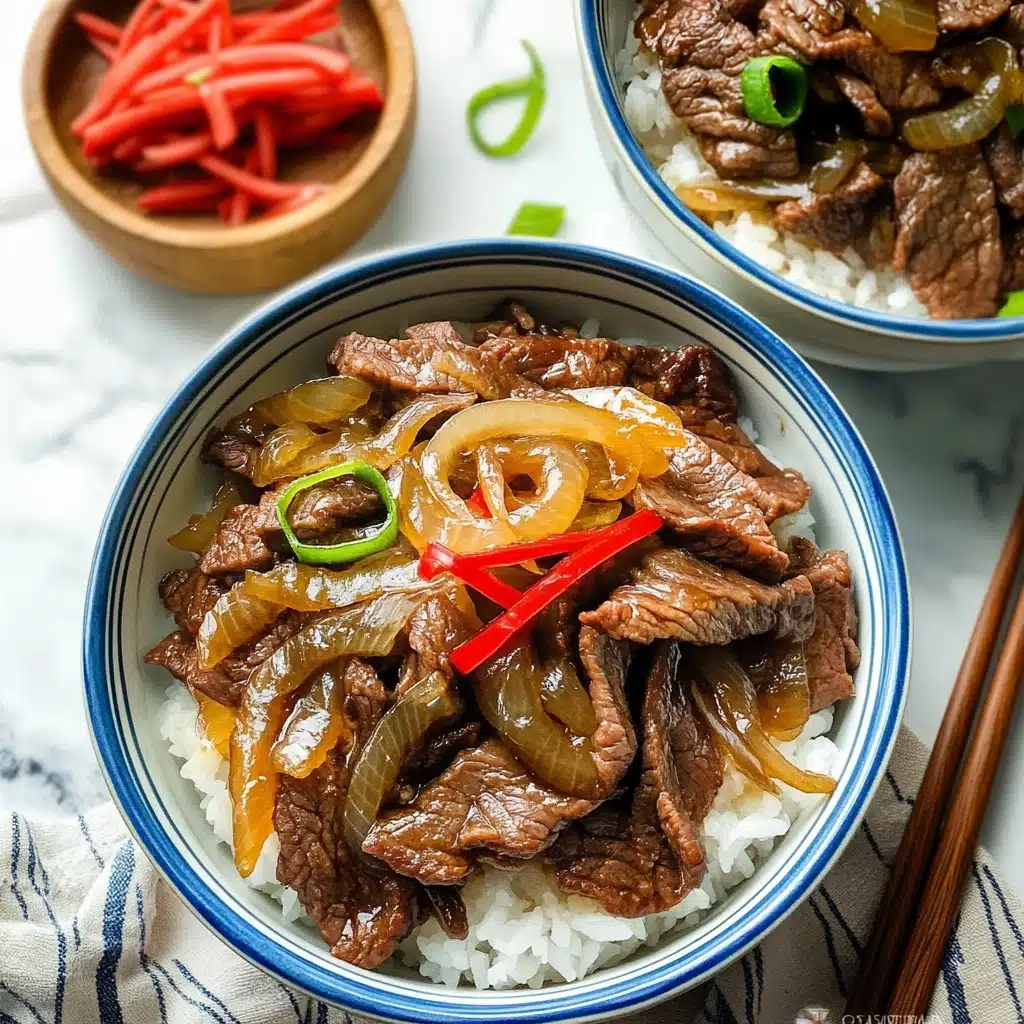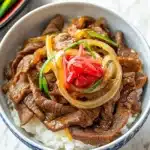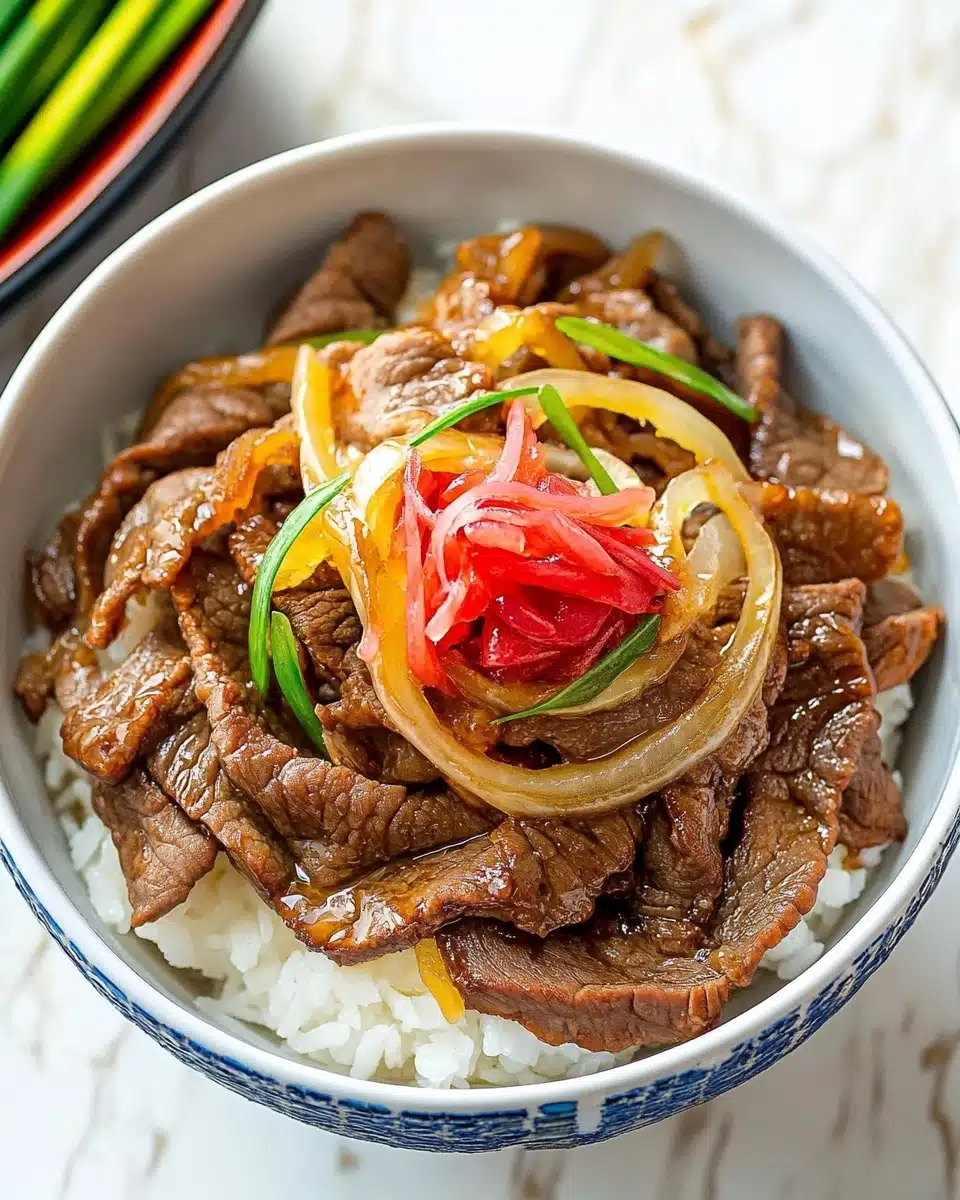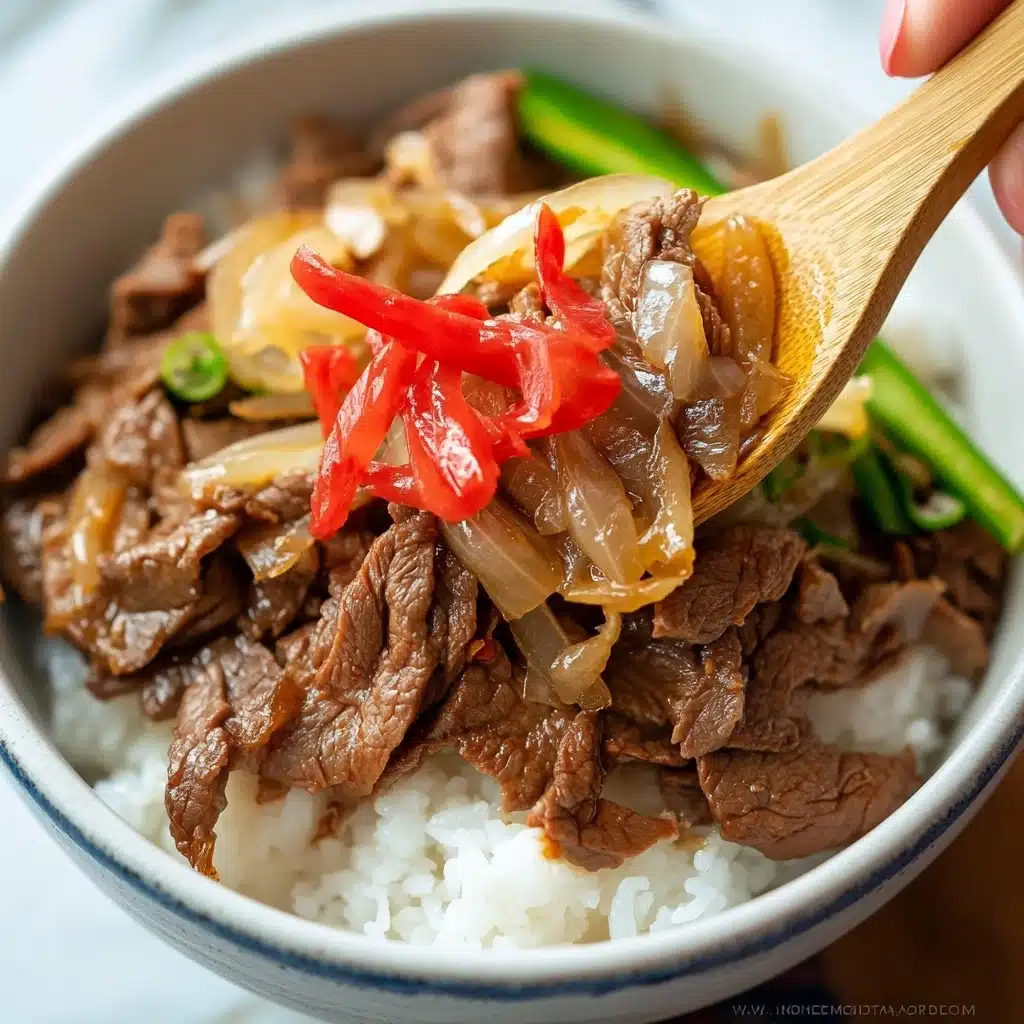I absolutely love sharing this Gyudon (Japanese Beef Rice Bowl) Recipe with you because it’s one of those comforting, soul-satisfying meals that makes weeknight dinners feel special without any fuss. When I first tried making gyudon at home, I was amazed at how a few simple ingredients could create such a rich, flavorful dish that quickly became a family favorite. You’ll find that this recipe is perfect whenever you want something cozy, quick, and truly delicious.
What makes this Gyudon (Japanese Beef Rice Bowl) Recipe worth trying is how it beautifully balances savory and sweet flavors, thanks to that classic dashi-based sauce paired with tender beef and onions. Plus, it’s versatile enough for busy days or when you want to impress friends with authentic Japanese comfort food. Trust me, once you get the hang of it, you’ll be making it regularly – I know I do!
Why You’ll Love This Recipe
- Quick and Easy: You can have a restaurant-quality meal ready in about 20 minutes.
- Authentic Flavor: The use of dashi and mirin gives it that unmistakable Japanese taste you’ll crave.
- Family Friendly: My family goes crazy for this dish, and it’s a great way to introduce Japanese cuisine to kids.
- Versatile Base: You can customize it with eggs, green onions, or different garnishes to keep it fresh every time.
Ingredients You’ll Need
The ingredients for this Gyudon (Japanese Beef Rice Bowl) Recipe come together beautifully to create that signature sweet-savory flavor. Using Japanese short-grain rice and dashi really brings authenticity to the dish, while the thinly sliced beef cooks quickly and stays tender.
- Onion: Thinly sliced onions add subtle sweetness and soften perfectly in the simmering sauce.
- Green onion/scallion: Adds lovely freshness and a mild sharpness as a finishing touch.
- Thinly sliced beef (ribeye or similar): Thin slices cook super fast and remain juicy, giving that melt-in-your-mouth texture.
- Dashi (Japanese soup stock): The cornerstone of that umami-packed broth; you can use traditional or powdered dashi.
- Sake: Adds depth and a gentle sweetness—substitutions like sherry work in a pinch.
- Mirin: A sweet rice wine that balances savory flavors and helps create that perfect glaze.
- Soy sauce: For that salty, umami punch that ties everything together.
- Sugar: Just enough to brighten the sauce with a touch of sweetness.
- Cooked Japanese short-grain rice: The ideal rice for donburi bowls because it’s sticky and slightly chewy.
- Pickled red ginger (beni shoga): A bright, tangy garnish that cuts through the richness and makes every bite pop.
Variations
I like to experiment with this Gyudon (Japanese Beef Rice Bowl) Recipe depending on what I have on hand or the mood I’m in. It’s pretty forgiving, so feel free to make it your own by tweaking the toppings or adjusting the sweetness to your liking.
- Egg Variation: I love adding a softly beaten egg or even a poached egg on top for extra creaminess—it’s a simple upgrade that my family adores.
- Vegetarian Version: Swap the beef for mushrooms and use vegan dashi to keep that umami flavor intact without any meat.
- Spicy Kick: Try adding a dash of shichimi togarashi (Japanese seven-spice) or a touch of chili oil for a bit of heat if that’s your style.
- More Veggies: Stir in some spinach or thinly sliced carrots with the onions to boost nutrition and color.
How to Make Gyudon (Japanese Beef Rice Bowl) Recipe
Step 1: Prep Your Ingredients
Start by thinly slicing half an onion and cutting a green onion diagonally into thin pieces. I find it’s easiest to slice the beef when it’s slightly frozen—just pop it in the freezer for about 10 minutes beforehand and then cut it into roughly 3-inch wide strips. This helps get even, thin slices quickly without the meat tearing.
Step 2: Combine the Sauce Ingredients
In a large frying pan (don’t turn on the heat just yet), pour in the dashi, sake, mirin, soy sauce, and sugar. Stir everything together to dissolve the sugar. This mixture is where all the magic happens—it’s the savory-sweet broth that your gyudon will simmer in.
Step 3: Simmer the Onions and Beef
Add your sliced onions to the pan, spreading them evenly so they get coated in the broth and separate nicely. Then layer your beef strips over the onions, again separating the slices so each piece cooks evenly. Cover the pan with a lid and turn the heat to medium. Once it starts simmering, turn the heat down low and let it cook for about 3–4 minutes until the beef is just tender and the onions are soft.
Step 4: Skim and Finish Cooking
While it simmers, open the lid once or twice to skim off any foam or excess fat from the top with a fine-mesh skimmer. This step keeps the sauce clear and flavorful. After that, sprinkle the sliced green onions on top, cover again, and cook for one more minute. If you want to add beaten eggs for extra richness, now’s the time to gently drizzle them in—this will gently cook them into the gyudon.
Step 5: Serve Over Steamed Rice
Divide your cooked Japanese short-grain rice into bowls and drizzle a bit of the pan sauce over the rice to soak in. Then spoon the beef and onion mixture on top. Finish with some bright, tangy pickled red ginger—this little garnish seriously takes the dish up a notch with its refreshing bite. Serve immediately and enjoy the comforting layers of flavor!
Pro Tips for Making Gyudon (Japanese Beef Rice Bowl) Recipe
- Freeze the Beef Slightly: Trust me, slicing beef when it’s semi-frozen makes your work so much easier and your slices so much neater.
- Skim the Broth Regularly: Removing foam and fat keeps the sauce clear and tasting fresh without heaviness.
- Don’t Overcook the Beef: The slices are thin, so keep a close eye—overcooked beef gets tough and dry.
- Use Quality Dashi: I learned using a good dashi stock really elevates the umami and overall flavor complexity.
How to Serve Gyudon (Japanese Beef Rice Bowl) Recipe

Garnishes
I always top my gyudon with pickled red ginger – it’s bright, tangy, and perfectly contrasts the savory-sweet beef. Sometimes I sprinkle chopped green onions or even a few toasted sesame seeds for an extra layer of flavor and crunch. If you’re feeling adventurous, a soft-cooked egg on top adds a creamy richness that’s hard to beat.
Side Dishes
Gyudon pairs wonderfully with light sides like a simple miso soup, steamed edamame, or a crisp cucumber salad dressed in rice vinegar. I’ve also served it alongside pickled vegetables or a small bowl of seaweed salad to bring a refreshing balance to the meal.
Creative Ways to Present
For special occasions, I’ve plated gyudon in pretty donburi bowls, garnished with fresh shiso leaves and a sprinkle of shichimi togarashi for color and a subtle kick. It’s also fun to serve it in bento boxes with colorful sides arranged neatly – my kids love it when meals look bright and festive!
Make Ahead and Storage
Storing Leftovers
I store leftover beef and onions in an airtight container in the fridge for up to 2–3 days. Just be sure to cool it quickly before refrigerating to keep it fresh. Reheat gently so the beef stays tender without drying out.
Freezing
I’ve frozen gyudon leftovers successfully by portioning them into freezer-safe containers. They keep well for 3–4 weeks and thaw quickly overnight in the fridge. Just note that the texture of the beef is best the sooner you eat it after freezing.
Reheating
I usually reheat gyudon on the stovetop over low heat with a splash of water or dashi to keep the sauce silky. Microwaving works too—just cover loosely and heat in short bursts to avoid drying out the meat. Add fresh green onions or pickled ginger after reheating for a fresh hit of flavor.
FAQs
-
Can I use other cuts of beef for Gyudon (Japanese Beef Rice Bowl) Recipe?
Absolutely! Thinly sliced ribeye is great because it’s tender and flavorful, but you can also use sirloin or even chuck if sliced very thinly. The key is to cut the meat thin enough so it cooks quickly and remains tender in the simmering sauce.
-
What if I don’t have dashi?
If you don’t have dashi, you can substitute with a mild broth like chicken stock or vegetable broth, but the flavor won’t be quite as authentic. You could also use instant dashi powder or vegetarian dashi for a similar umami taste.
-
How do I make Gyudon without alcohol?
You can easily omit sake and mirin and replace them with a combination of water and a bit of sugar for sweetness. The flavor will be slightly different but still delicious and close to authentic taste.
-
Can I add eggs to Gyudon?
Yes! Adding beaten eggs during the last minute of simmering gives a smooth, silky texture to the dish (often called tanindon). You can also top each serving with a soft-cooked or raw egg yolk if you prefer.
Final Thoughts
I hope this Gyudon (Japanese Beef Rice Bowl) Recipe inspires you to bring a little bit of Japan into your kitchen. It’s a dish I personally keep coming back to because of its ease, comforting flavors, and the smiles it always brings to the table. Give it a try—once you make it, I bet it’ll become a favorite in your home too. Cooking gyudon is like waving a warm, savory hug at the end of your busy day, and honestly, who doesn’t want that?
Print
Gyudon (Japanese Beef Rice Bowl) Recipe
- Prep Time: 5 minutes
- Cook Time: 15 minutes
- Total Time: 20 minutes
- Yield: 2 servings
- Category: Main Dish
- Method: Stovetop
- Cuisine: Japanese
Description
Gyudon is a classic Japanese beef rice bowl featuring thinly sliced beef and onions simmered in a savory-sweet sauce of dashi, soy sauce, sake, and mirin, served over steamed Japanese short-grain rice. This quick and comforting dish balances tender meat with flavorful broth and picks up crispiness from pickled ginger, perfect for a satisfying meal any day.
Ingredients
Meat and Vegetable
- 1/2 onion (4 oz, 113 g), thinly sliced
- 1 green onion/scallion, sliced diagonally
- 1/2 lb thinly sliced beef (such as ribeye), cut into 3 inch (7.6 cm) wide pieces
Sauce
- 1/2 cup dashi (Japanese soup stock)
- 2 Tbsp sake (or dry sherry, Chinese rice wine, or water for non-alcohol)
- 2 Tbsp mirin (or 2 Tbsp sake/water plus 2 tsp sugar)
- 3 Tbsp soy sauce
- 1 Tbsp sugar (adjust to taste)
For Serving
- Cooked Japanese short-grain rice, 2 servings (about 1 2/3 cups or 250 g per serving)
- Pickled red ginger (beni shoga or kizami beni shoga) for garnish
Instructions
- Prepare Ingredients: Thinly slice ½ onion and slice the green onion diagonally. Partially freeze the beef for about 10 minutes then cut into 3 inch-wide pieces for ease of handling.
- Combine Sauce Ingredients: In a large frying pan (off heat), mix ½ cup dashi, 2 Tbsp sake, 2 Tbsp mirin, 3 Tbsp soy sauce, and 1 Tbsp sugar. Stir well to dissolve the sugar completely.
- Add Onion: Layer the thinly sliced onions evenly in the sauce in the pan, separating the onion layers to allow even cooking and flavor absorption.
- Arrange Beef: Place the beef slices over the onions, spreading and separating the pieces so the meat covers the onions evenly.
- Simmer: Cover the pan with a lid, turn heat to medium. Once it starts simmering, reduce to low and cook covered for 3–4 minutes.
- Skim Impurities: Occasionally lift the lid and skim off any scum or excess fat from the broth with a fine-mesh skimmer to keep the sauce clear.
- Add Green Onions: Sprinkle the sliced green onions on top, cover and cook for an additional minute. Optionally, beaten eggs can be added now as per personal preference.
- Serve: Place 2 servings of cooked Japanese short-grain rice into bowls. Drizzle some pan sauce over the rice, then top with the beef and onion mixture.
- Garnish and Enjoy: Add pickled red ginger on top for garnishing. Drizzle any remaining sauce over the dish as desired and serve immediately.
- Storage: Store any leftovers in an airtight container in the refrigerator for up to 2-3 days or freeze up to 3-4 weeks.
Notes
- For a variation called Kansai Sukiyaki-Style Gyudon, stir-fry onions in oil until tender, add beef and sugar and stir quickly, then add sake, mirin, and soy sauce until beef is cooked. Add beaten egg gently and cook covered until set. Serve over rice.
- Partially freezing the beef makes it easier to slice thinly and evenly.
- If a non-alcoholic version is desired, substitute sake with water and slightly increase sugar to balance flavor.
- Use a fine-mesh skimmer while simmering to keep broth clear and remove excess fat.
- Pickled red ginger adds a bright, tangy contrast that enhances the dish’s flavor profile.
- Use authentic Japanese short-grain rice for the best texture and traditional experience.




I know this site gives quality based content and other data,
is there any other web site which presents these things in quality?